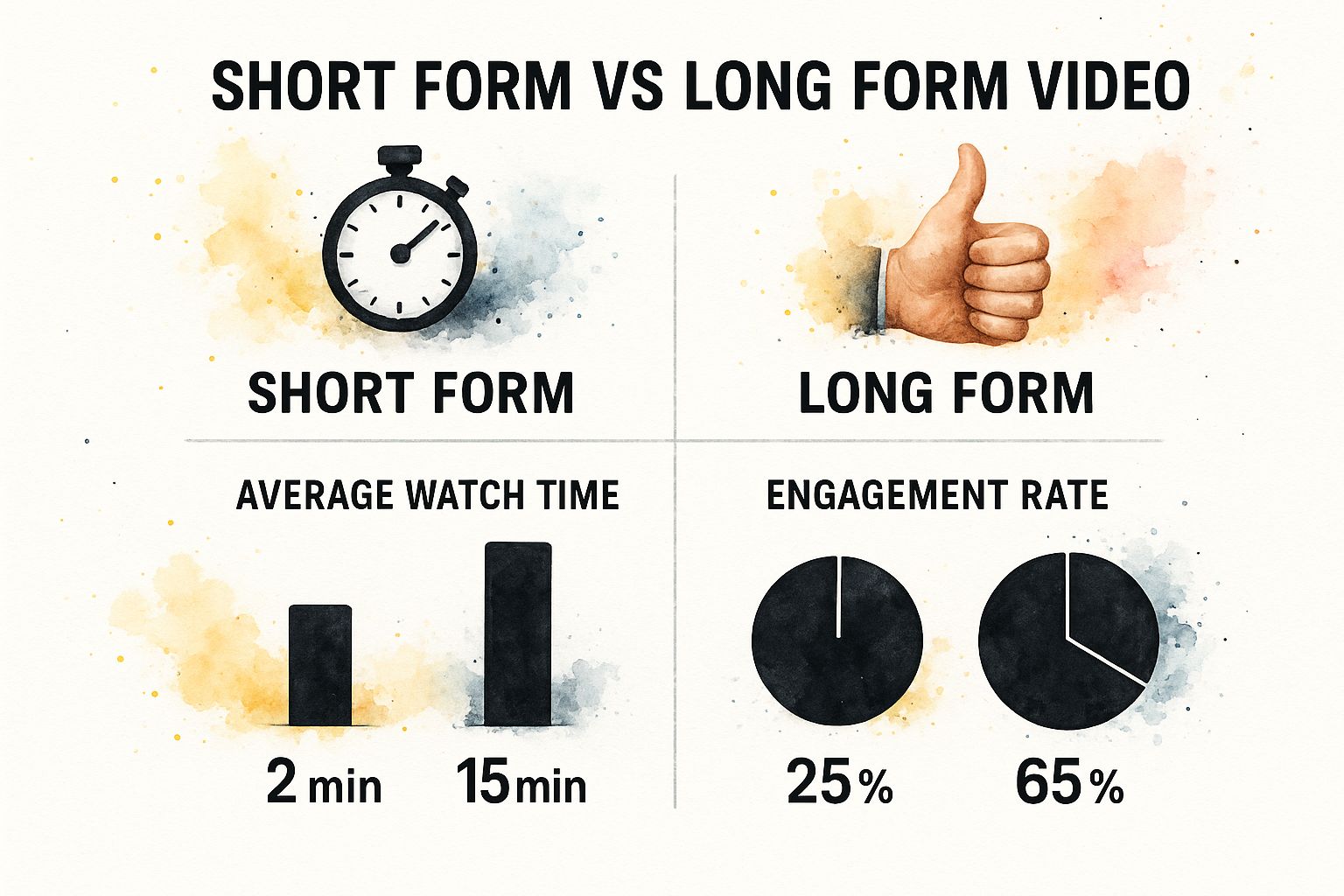In a world seemingly obsessed with 15-second clips and endless scrolling, you might think long-form video is a relic of the past. But it's making a serious comeback, and for good reason.
Think of short-form content like a catchy headline—it grabs your attention in a flash. Long-form video, on the other hand, is the full, deeply reported article. It’s where the real value lies, building lasting trust and connection with your audience.
We're talking about any video that clocks in at 10 minutes or more. But it’s not just about the length; it's about the purpose. This format gives you the space to tell a real story, unpack a complex topic, or guide someone through a detailed process.
Moving Beyond the Clock
The real magic of long-form video isn't tied to a specific timestamp. It’s about what you can achieve when you have room to breathe. The goal is to:
- Educate and Inform: This is your chance to create detailed tutorials, in-depth product demos, or comprehensive webinars that genuinely help your audience. They walk away feeling smarter and more capable.
- Entertain and Engage: You can craft rich documentaries, compelling interviews, or binge-worthy video podcasts that keep viewers hooked and turn them into loyal fans.
- Build Trust and Authority: By providing exhaustive, high-quality information, you establish your brand as the expert. You're offering a level of detail that a 60-second clip simply can't match.
The infographic below paints a clear picture of how viewers interact differently with short and long videos.

While short clips get quick views, the data shows that long-form content drives significantly higher engagement. This signals an audience that is truly invested and paying attention.
To quickly see how these two formats stack up, here's a side-by-side comparison.
Long Form vs Short Form Video At a Glance
| Attribute | Long Form Video | Short Form Video |
|---|---|---|
| Typical Length | 10+ minutes | Under 3 minutes |
| Primary Goal | Educate, build trust, create deep engagement | Grab attention, entertain, generate awareness |
| Content Style | In-depth, narrative-driven, comprehensive | Quick, punchy, easily digestible |
| Ideal Platforms | YouTube, Vimeo, company websites, webinars | TikTok, Instagram Reels, YouTube Shorts, X |
| Audience Mindset | Intentional, seeking information or deep entertainment | Passive scrolling, looking for quick bites |
This table makes it clear: the choice isn't about which one is "better," but which one is right for your specific goal.
The Strategic Advantage of Depth
The appetite for substantial, meaningful content is only growing. Projections show that video will make up a staggering 82% of all internet traffic by 2025. This isn't just about viral clips; it reflects a deep-seated desire for content that teaches, inspires, and connects. To dig deeper into this trend, explore more on the power of video.
Long-form video succeeds because it trades fleeting views for meaningful engagement. It's a strategic decision to invest in building a relationship with your audience, one detailed explanation at a time.
Of course, creating great long-form content means it needs to fit into your wider strategy. Brushing up on content marketing best practices will ensure that every deep-dive video you produce serves a clear purpose in your overall marketing plan.
The Business Case for Long Form Video
 It’s easy to think of long-form video as a creative expense, but it’s far more than that. It’s a strategic asset. A fleeting social media clip might get you a quick like, but a truly comprehensive video acts as a powerful engine for real business growth, driving everything from your search rankings to your sales conversions.
It’s easy to think of long-form video as a creative expense, but it’s far more than that. It’s a strategic asset. A fleeting social media clip might get you a quick like, but a truly comprehensive video acts as a powerful engine for real business growth, driving everything from your search rankings to your sales conversions.
This format taps directly into what search engines like Google and YouTube value most: quality and user engagement. Think about it. When a viewer commits to watching a 15-minute deep dive on a topic, they’re sending a massive signal that your content is valuable. This extended watch time is a golden metric that can seriously boost your video’s discoverability and overall SEO.
From Content Creator to Industry Authority
Beyond just pleasing the algorithms, long-form video is one of the best ways to cement your brand as a trusted authority. It gives you the canvas you need to go beyond surface-level tips and offer genuinely comprehensive guidance. It's the difference between sharing a quick recipe and hosting a full-on cooking masterclass.
This depth completely changes how people see your brand. You’re no longer just another voice in the crowd; you become the go-to resource people actively seek out for reliable answers. That trust is the very foundation of long-term customer loyalty and is absolutely essential for building a dedicated community. For a closer look at this strategy, you can explore the compelling case for scaling your video investment.
Guiding Customers and Driving Conversions
This is where long-form video really starts to work its magic on your bottom line. It’s fantastic at nurturing potential customers through their entire buying journey. A detailed tutorial, an in-depth product walkthrough, or an educational webinar can answer questions, overcome objections, and build the confidence someone needs to finally click "buy."
By dedicating time to educate your audience, you are not just selling a product; you are building a relationship. This educational approach fosters trust and naturally leads to higher conversion rates.
The numbers back this up. In fact, approximately 89% of businesses are now using video in their marketing, with many finding it dramatically increases conversion rates.
Ultimately, creating substantial video content is a direct investment in your business’s future. It opens up multiple avenues for monetization, from ad revenue to sponsored content. Understanding the different platforms is key, which is why resources comparing options like Ko-fi vs. Patreon for creators are so valuable. By combining authority-building content with a smart monetization plan, long-form video becomes a true cornerstone of sustainable growth.
Choosing the Right Format for Your Story

Okay, so you're ready to create a long-form video. What's next? You need to figure out what kind of story you're going to tell.
Think of the format as the right tool for the job. Each one has its own unique strengths, perfectly suited for different goals and audiences. It’s all about matching your message with the most effective way to deliver it.
Picking the right format is the key to making sure your content actually connects and hits its mark, whether you’re trying to teach your audience something new or build a die-hard community. Let's look at a few of the most powerful formats that consistently grab and hold viewers' attention.
Educational Tutorials and Deep Dives
This is the classic way to establish yourself as an authority. We're talking about a comprehensive guide that walks a viewer, step-by-step, through a complex process to solve a real problem they're facing. These videos are gold for search engines and pull in an audience that knows exactly what they're looking for.
The main goal here is to deliver undeniable value. When you teach someone something genuinely useful, you build trust and become the go-to resource in your space. Your audience isn't just watching; they're learning, which forges a powerful, positive connection to your brand.
Video Podcasts and Expert Interviews
If building a community is your top priority, video podcasts and interviews are where it's at. This format puts a human face on your brand, creating a personal connection that’s tough to achieve with just text on a screen. It feels less like a presentation and more like a real, engaging conversation.
These formats run on personality and genuine insight. Bringing in industry experts not only gives your audience fresh perspectives but also lets you tap into their audience, instantly expanding your reach. This conversational style is perfect for digging into nuanced topics and sharing a wide range of viewpoints.
A great interview or podcast episode makes the viewer feel like they're right there in the room, getting exclusive insights. It flips passive watching into an active, community-driven experience.
Webinars and Product Walkthroughs
When your goal is to generate leads and drive sales, webinars and in-depth product walkthroughs are incredibly effective. A live or pre-recorded webinar gives you a platform to present detailed information and interact directly with potential customers through a Q&A.
Likewise, a product walkthrough is so much more than a quick demo. It’s your chance to show off every feature, tackle common pain points, and prove the real-world value your product delivers. This format is crucial for guiding potential customers through the final, critical stages of their decision.
Mastering this requires a sharp sense of narrative. You can explore more top video storytelling tips to create engaging content to really nail your approach.
How to Create Videos People Actually Finish
Let’s be honest. The hardest part of long-form video isn’t getting the click. It’s getting someone to stick around. In a world where the next distraction is just a swipe away, holding attention for ten, twenty, or even thirty minutes is a real art form. You have to turn a passive viewing session into a journey they don't want to end.
Those first 30 seconds? That's your entire audition. If you can't land a knockout hook—a surprising stat, a challenging question, or a clear promise of what's to come—they're gone. You have to give people a powerful reason to stop scrolling and listen to what you have to say.
Architecting an Engaging Narrative
The best long-form videos aren't just a random collection of clips and facts. They follow a classic story arc: a beginning, a middle, and an end. This structure is more than just a creative choice; it’s a roadmap that guides your viewer, making even complicated topics feel simple and easy to follow.
You start by setting the scene and introducing the core problem or idea. The middle is where you build your case, layering in new insights, evidence, and examples in a way that feels natural and logical. Then, the conclusion ties it all together, delivering a satisfying payoff that makes good on the promise you made in your hook.
The real secret to keeping viewers hooked is making them feel like they're making progress. A clear structure, highlighted with visual signposts, transforms a long video from a marathon into a series of achievable, rewarding steps.
Visuals are your best friend here. They keep your audience oriented and engaged. Try using a few of these tricks to guide them along:
- Timestamps: Break your video into chapters right in the description. This lets viewers jump to the parts they care about most and gives them a bird's-eye view of the entire video.
- On-Screen Graphics: Use text overlays, title cards, and even subtle progress bars to signal when you're moving to a new topic. It’s like a visual GPS that keeps people from getting lost or bored.
- Pattern Interrupts: Throw in something unexpected. A quick zoom, a sudden sound effect, or a clever graphic can instantly reset your viewer's attention and keep the energy high.
Polishing Your Production for Maximum Retention
Your production quality says a lot about your credibility. You don't need a Hollywood budget, but getting a few key things right can make a world of difference in how long people stick around.
First, crisp, clear audio is non-negotiable. People will forgive shaky camerawork long before they'll put up with bad sound. A decent microphone and a quiet recording space are your best investments—they ensure your message comes through loud and clear.
Next, mix up your shots. No one wants to stare at the same static frame for 20 minutes; it's mentally exhausting. This is where B-roll comes in. Splicing in supplemental footage that shows what you’re talking about makes your video far more dynamic and visually engaging. It breaks up the monotony and drives your points home.
Even though about 70% of YouTube's watch time happens on mobile, long-form is still crushing it by adapting. Smart creators are baking in features like captions and interactive elements to keep viewers locked in. This relentless focus on the viewer's experience is why 90% of marketers see a major boost in brand awareness from video. To get a deeper dive into what's working now, check out the latest video marketing statistics from Insivia.
Getting Your Video Seen: A Promotion Game Plan

Here's the hard truth: creating a brilliant long-form video is just the beginning. Without a solid plan to get it in front of people, all that hard work might just echo into the digital void. We have to move past the "upload and pray" mindset to see a real return on our creative investment. A great video deserves a great promotion strategy to match.
It all starts right where you host the video, which for most of us is YouTube. Think of your video's title, description, and tags as the sign on its front door. They need to be optimized so the right people can find their way in. A sharp, keyword-rich title is what grabs someone's attention in a crowded feed, and a detailed description tells YouTube's algorithm exactly what your video is about, giving it a much better chance of showing up in search results.
Get More Mileage by Repurposing
One of the single biggest perks of long-form video is how easily it can be chopped up and repurposed. Your main video isn't just one piece of content; it's a treasure chest of smaller, snackable assets. This is how you can fuel your entire content calendar from one cornerstone creation.
Your long-form video should be the sun in your content solar system. Every short clip, quote card, and GIF you create should orbit around it, pulling audiences from different platforms back to the main event.
This strategy lets you meet your audience where they already are. Instead of asking someone scrolling through Instagram to commit to a 20-minute video, you can hook them with a powerful 30-second clip that makes them want to see the rest.
- Short Video Clips: Snip out the most compelling moments, the biggest "aha!" takeaways, or a surprising statistic. These are pure gold for platforms like Instagram Reels, TikTok, and YouTube Shorts.
- Quote Cards: Did an expert drop a powerful one-liner? Turn it into a slick, shareable graphic for LinkedIn, X, or your Instagram feed.
- Animated GIFs: Create short, looping animations of key visuals from the video. They’re perfect for adding a bit of personality and movement to your social posts.
Don't Forget Your Home Turf
Finally, make sure you're tapping into the channels you own and control. Your most dedicated followers live on your email list and your website. An email newsletter is the perfect way to announce your shiny new video to an audience that's already eager to hear from you.
Embedding the video directly into a relevant blog post is another killer move. It gives your site visitors incredible value, and just as importantly, it can seriously boost the time they spend on your page. That's a key signal to search engines that your site is a source of high-quality, engaging material. By hitting all these channels, you ensure your video doesn't just get published—it gets seen.
Answering Your Long-Form Video Questions
Jumping into long-form video can feel like a big step. It’s a real investment of time and resources, so it’s completely normal to have a few questions before you dive in. You want to make sure you’re headed in the right direction. Let's tackle some of the most common hurdles creators run into.
A lot of people get hung up on the "perfect" length. Is 12 minutes the sweet spot? Is 45 minutes way too long? The honest answer is there’s no magic number. Your video should be exactly as long as it needs to be to deliver on its promise—and not a second longer. A video’s success isn't measured with a stopwatch; it's measured by its ability to keep people watching.
How Long Is Too Long?
The trick is to let your topic and your story determine the runtime. A straightforward how-to video might only need 12 minutes to get the job done, while a deep-dive documentary could easily hold an audience for 45 minutes or more. Just focus on the story you're telling and the value you promised.
The real question isn't "How long should my video be?" It's "How long can I hold my audience's attention while delivering complete value?" Once you can answer that, you've found your ideal length.
Instead of obsessing over a specific minute count, pay close attention to your audience retention graph. That’s your most honest form of feedback. If you see a huge drop-off at the five-minute mark, it doesn't mean all your videos have to be under five minutes. It’s a signal to go back and look at that section to figure out what went wrong with the pacing or the content.
Creating Great Videos on a Budget
Another big thing that holds people back is the cost. It’s easy to look at amazing long-form content and assume it requires a Hollywood-sized budget, but that just isn’t the case anymore. Incredible quality is more accessible than ever.
The most critical investments aren't always the most expensive ones. If you're going to spend money anywhere, put it here:
- Clear Audio: People will forgive a slightly shaky camera, but they absolutely will not stick around for bad audio. A decent, affordable microphone is one of the single best purchases you can make to immediately make your videos feel more professional.
- Good Lighting: You don’t need a fancy studio setup. A simple ring light can work wonders, and so can positioning yourself in front of a window with good natural light. It makes a massive difference in your visual quality.
Beyond the gear, your most valuable asset is a solid plan. A well-structured script and meticulous pre-production will save you a ton of time and money when it’s time to shoot and edit.
Measuring What Truly Matters
Once your video is out in the world, it’s so tempting to refresh the view count over and over. But views only scratch the surface. To really understand how your long-form video is performing, you need to dig into the engagement metrics.
These are the numbers you should actually be watching:
- Average View Duration: This tells you how much of your video people are actually watching on average. A high average view duration is a huge signal to platforms like YouTube that people are finding your content valuable.
- Audience Retention: This graph is a goldmine. It shows you, second by second, where people are hooked and where they’re bailing. Use it as a diagnostic tool to pinpoint weak spots in your storytelling.
- Click-Through Rate (CTR): How many people who see your video’s title and thumbnail actually click to watch? A low CTR could mean your awesome video isn't getting the chance it deserves because the packaging isn't compelling enough.
Repurposing for Maximum ROI
Finally, one of the smartest things you can do is never let a long-form video exist as just one piece of content. Think of it as a content goldmine. With a bit of strategic thinking, one 20-minute video can power your social media content for weeks.
Watch through your video and pull out the best moments—a killer quote, a surprising statistic, a key takeaway. Then, chop them up and reformat them for different platforms. A single deep-dive video can be turned into dozens of smaller assets, dramatically extending its lifespan and maximizing your return on effort.
At Aeon, we turn your existing content into a massive library of high-quality videos, automatically. Our platform helps publishers create engaging video at scale, transforming articles, podcasts, and raw footage into perfectly formatted content for every channel. See how Aeon can amplify your content strategy.